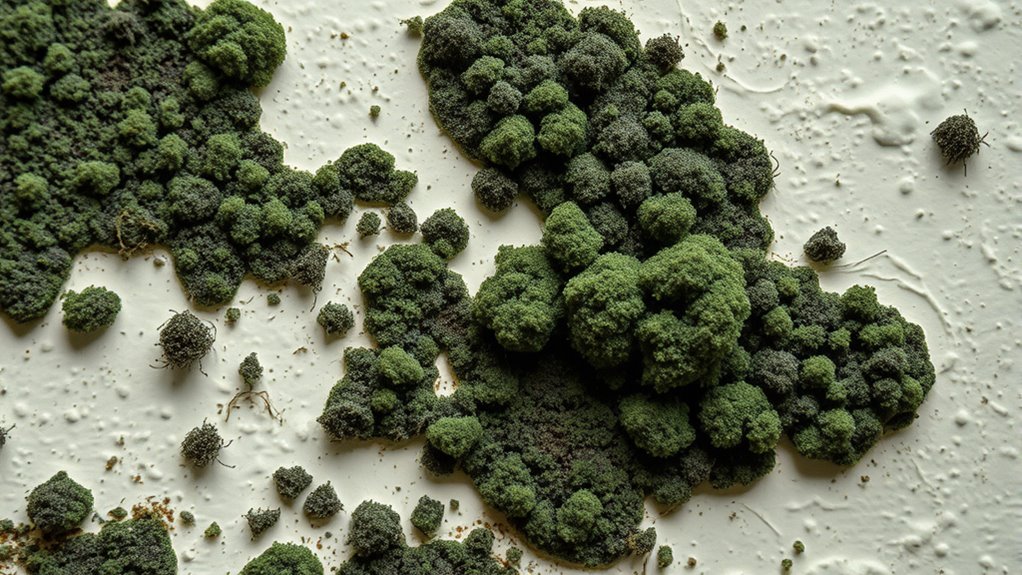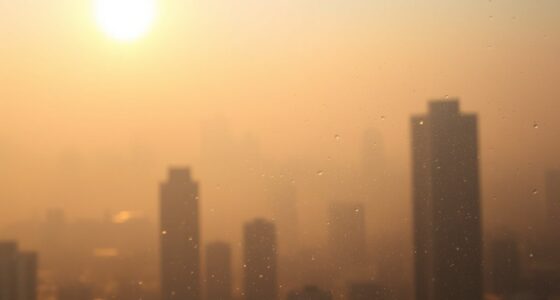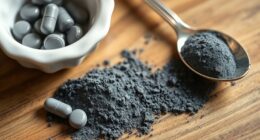Mold spores are tiny particles released by mold that can easily become airborne, spreading throughout your home. When inhaled or touched, they can trigger allergies, asthma, and respiratory issues, especially in sensitive individuals. To address this, identify and remove mold from damp areas using proper safety steps, like cleaning with protective gear, and consider testing for hidden growth. Keep moisture levels low to prevent future problems. If you want to understand the best removal techniques, there’s more you should know.
Key Takeaways
- Mold spores can trigger allergies, asthma, respiratory issues, and skin reactions, especially in sensitive or immunocompromised individuals.
- Visible mold, musty odors, and water damage indicate potential health risks from indoor mold growth.
- Effective remediation includes identifying moisture sources, cleaning surfaces, removing contaminated materials, and improving ventilation.
- Air and surface testing help determine mold spore levels and guide appropriate remediation strategies.
- Preventing mold involves controlling humidity, fixing leaks promptly, and ensuring proper ventilation in damp areas.
What Are Mold Spores and How Do They Spread
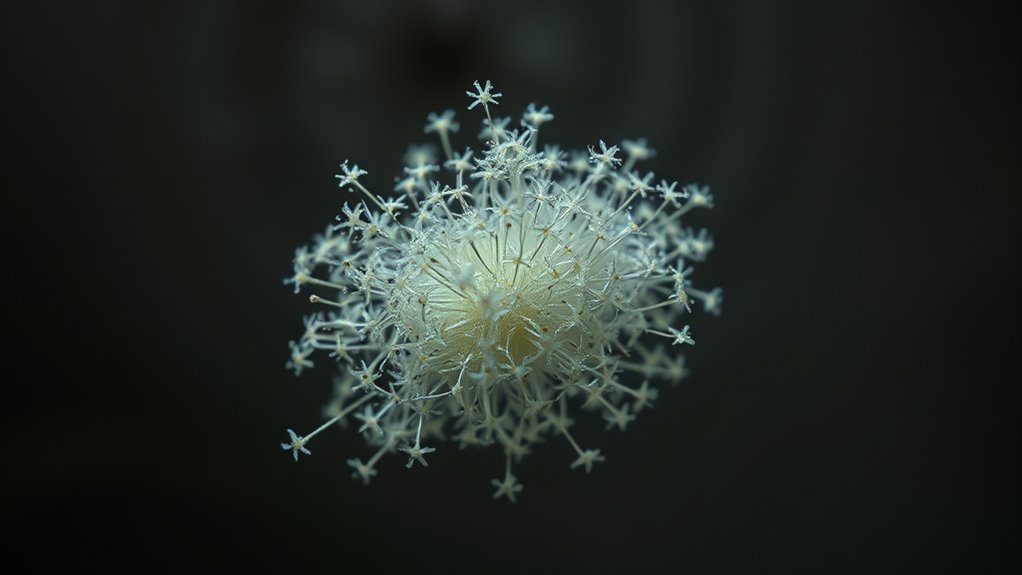
Mold spores are tiny reproductive units released by mold colonies to spread and grow in new areas. These microscopic particles are lightweight, allowing them to become airborne easily when disturbed or during natural air currents. Once airborne, you can breathe them in, which may lead to health issues, especially for sensitive individuals. Mold spores are highly resilient, capable of surviving in harsh conditions until they find a suitable environment to grow. They travel through the air, attaching to clothing, pets, or objects, and settle on surfaces where moisture and organic material are present. This ability to disperse widely makes mold a common indoor problem, especially in damp or poorly ventilated spaces. The presence of high-quality spores can significantly influence the severity of mold-related health effects. Understanding how spores spread is key to preventing mold growth and maintaining a healthy environment.
Common Sources and Signs of Mold Growth
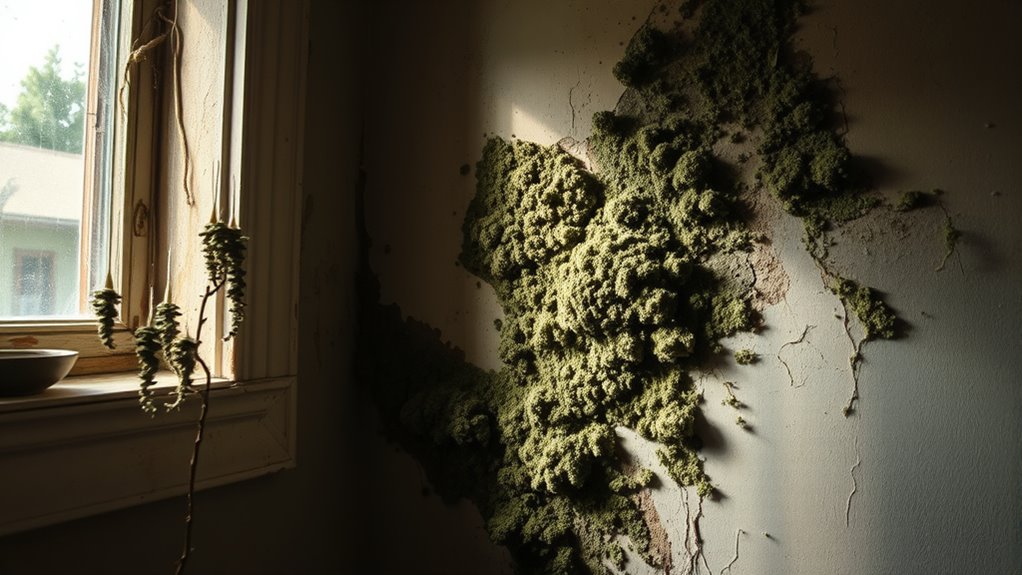
You’re most likely to find mold growing in areas with excess moisture or water damage. Common sources include leaks from pipes, roofs, or windows, as well as high humidity levels. Check bathrooms, basements, kitchens, and around appliances like washing machines for signs of water intrusion. Visible mold appears as black, green, or white patches on walls, ceilings, or surfaces. You might notice a musty odor that lingers even after cleaning. Discolored spots or peeling paint can also signal underlying mold growth. Keep an eye on areas prone to condensation, such as window sills and HVAC systems. If you spot any of these signs, it’s essential to address the moisture problem promptly to prevent mold from spreading further. Understanding the power of electric tools and devices can help you better manage moisture and prevent mold development.
Health Risks Associated With Mold Exposure
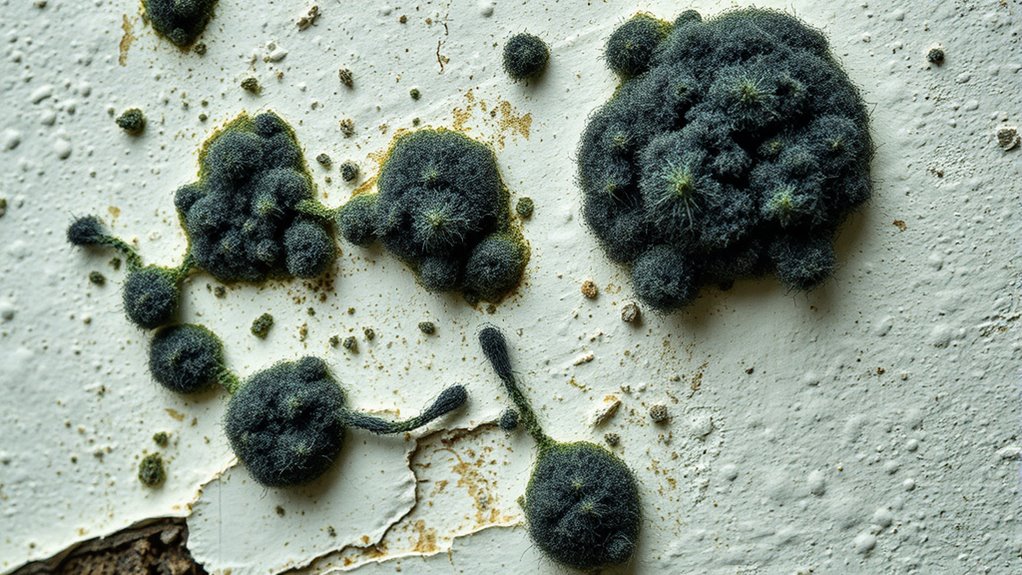
Exposure to mold spores can pose serious health risks, especially for individuals with allergies, asthma, or compromised immune systems. You might experience respiratory issues or worsening of existing conditions. Mold spores can also trigger allergic reactions, causing symptoms like sneezing, runny nose, or skin irritation. In vulnerable populations, exposure can lead to more severe health problems, such as infections or chronic respiratory illnesses.
Exposure to mold spores can worsen allergies, asthma, and immune system issues.
Consider these risks:
- Respiratory problems, including wheezing and coughing
- Allergic reactions, like skin rashes or eye irritation
- Exacerbation of asthma symptoms
- Infections in immunocompromised individuals
Being aware of these risks helps you take precautions to minimize exposure and protect your health.
Symptoms to Watch For After Mold Exposure
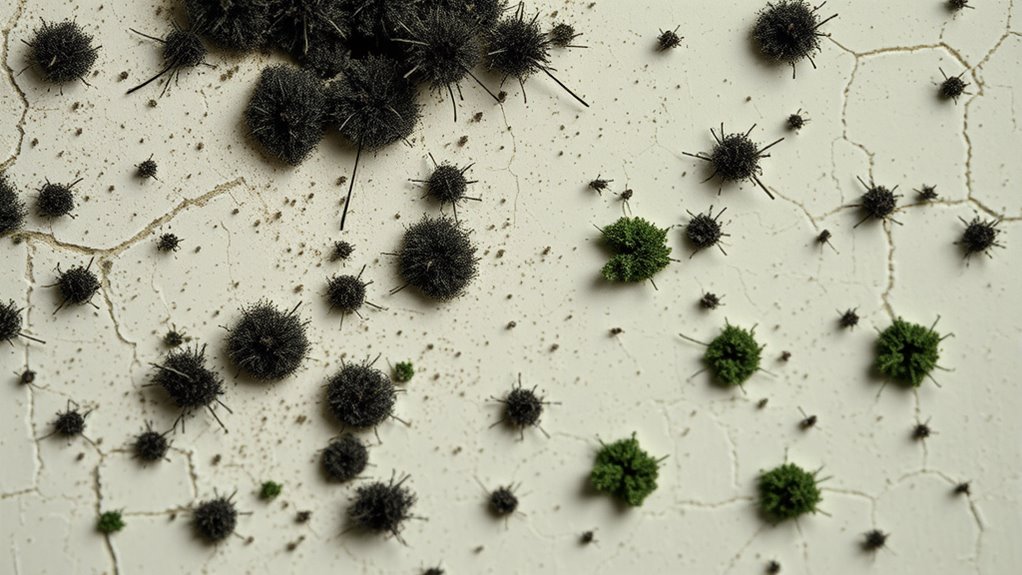
After encountering mold spores, it’s important to recognize the symptoms that may indicate a reaction or health issue. You might experience allergic reactions like sneezing, runny nose, or itchy eyes. Respiratory problems such as coughing, wheezing, or shortness of breath are common signs. Some people develop skin irritation, including rashes or hives. If you notice persistent headaches, fatigue, or sinus congestion, these could also be linked to mold exposure. In more severe cases, especially if you have allergies or asthma, symptoms may worsen, leading to chest tightness or difficulty breathing. Pay attention to any new or unusual symptoms, especially if they linger or worsen over time. Recognizing these signs early helps you take appropriate steps for testing and remediation. Vetted information about mold health effects can guide you in understanding these symptoms better.
Effective Methods for Mold Inspection and Testing

To effectively identify mold presence in your home, start with a thorough visual inspection, looking for visible mold growth, water stains, or signs of moisture damage. Check areas prone to humidity, like bathrooms, basements, and around windows. Once you’ve completed the visual check, consider testing to confirm mold presence. Here are four key methods:
- Air Sampling: Measures airborne mold spores to assess overall mold levels.
- Surface Testing: Swabs or tape lifts identify mold on specific surfaces.
- Bulk Sampling: Collects small material samples from suspected areas for lab analysis.
- Moisture Meters: Detects hidden moisture behind walls or ceilings, pinpointing hidden mold sources. Ensuring proper testing methods can prevent health risks from mold and guide effective remediation.
Strategies for Removing and Cleaning Mold Safely
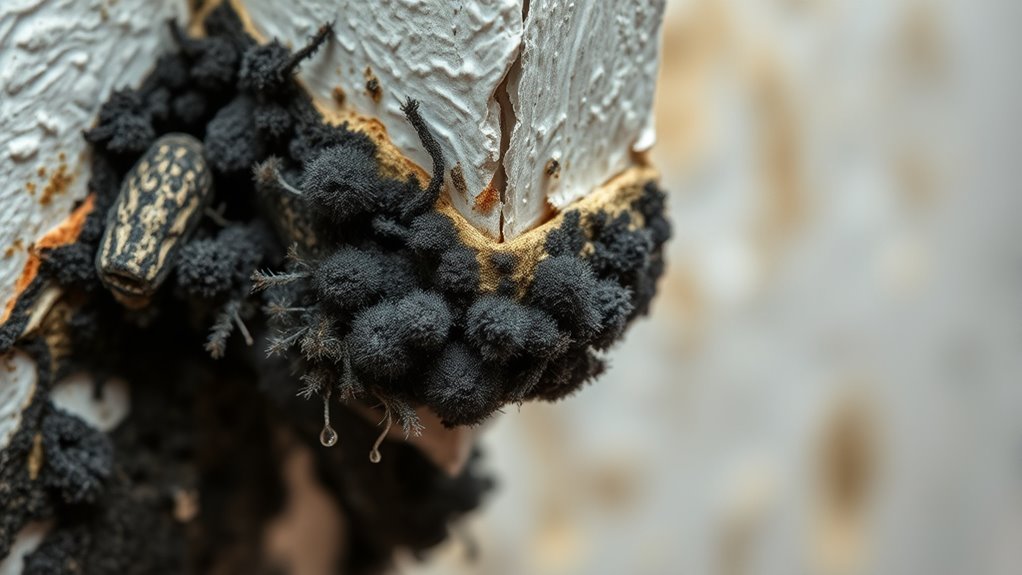
When removing mold from your home, safety should be your top priority. Wear protective gear like gloves, goggles, and an N95 mask to avoid inhaling spores. Ventilate the area by opening windows and doors to reduce airborne mold. Use detergent and water or a commercial mold cleaner to scrub affected surfaces thoroughly. For porous materials like drywall or carpeting, it’s best to discard and replace them, as mold can penetrate deeply. Avoid dry brushing or dry wiping, which can spread spores. After cleaning, dry the area completely to prevent mold from returning. Dispose of contaminated materials carefully in sealed bags. Remember, if the mold covers more than 10 square feet or is caused by sewage, consider hiring professionals for safe removal.
Preventative Measures to Reduce Mold Growth
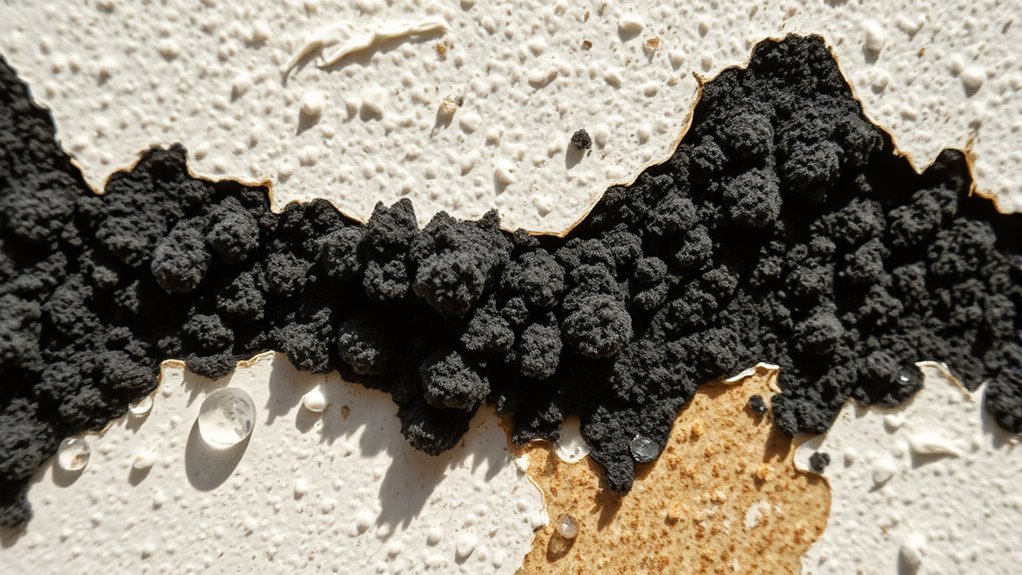
Preventing mold growth starts with controlling moisture levels in your home. Keep humidity below 60% using dehumidifiers or air conditioners. Ensure proper ventilation in bathrooms, kitchens, and laundry areas by running exhaust fans or opening windows. Regularly inspect for leaks in pipes, roofs, or windows, and fix them promptly to prevent water accumulation. Use mold-resistant products like paint and drywall in areas prone to moisture. Additionally, dry wet surfaces and fabrics within 24 to 48 hours to prevent mold spores from settling. Incorporating skincare innovation techniques can also help maintain a healthier, mold-free space and reduce the risk of mold-related health issues. Taking proactive steps will help maintain a healthier, mold-free space and reduce the risk of mold-related health issues.
When to Seek Professional Mold Remediation

Despite your best efforts to control moisture and keep mold at bay, there are times when professional intervention becomes necessary. If you notice extensive mold growth covering large areas or persistent mold despite cleaning, it’s time to call in experts. Significant water damage, such as flooding or leaks, often requires professional remediation to ensure thorough removal and prevent regrowth. If mold has penetrated hidden areas like behind walls or under floors, DIY efforts won’t suffice. Additionally, if you experience health symptoms like persistent coughing, allergies, or respiratory issues, professionals can assess and address hidden mold sources safely. Remember, mold can pose serious health risks, so recognizing when to seek expert help guarantees proper cleanup and peace of mind.
Frequently Asked Questions
Can Mold Spores Cause Long-Term Health Problems?
You might wonder if mold spores can cause long-term health issues. The answer is yes, especially if you’re exposed repeatedly or have allergies, asthma, or a compromised immune system. Mold spores can trigger or worsen respiratory problems, chronic coughs, and sinus issues. In some cases, long-term exposure may lead to more serious conditions like infections or neurological effects. It is crucial to address mold concerns promptly to protect your health.
Are There Specific Molds More Harmful Than Others?
Like a ticking time bomb, certain molds pose greater health risks than others. You should be especially cautious of black mold (Stachybotrys chartarum) and Aspergillus, as they produce potent toxins that can cause severe respiratory issues and allergic reactions. While many molds are harmless, these dangerous varieties can impact your health long-term. Regular inspection and prompt remediation are essential to prevent harmful exposure, protecting your well-being.
How Do Mold Spores Affect Indoor Air Quality?
You might notice mold spores impact indoor air quality by making the air feel stale or musty. When mold spores are present in large quantities, they can lower air quality and trigger allergies or respiratory issues. As you breathe, these spores can irritate your lungs, cause sneezing, or worsen asthma symptoms. Regular cleaning and ventilation help reduce spores and improve your indoor air, keeping it healthier and safer to breathe.
Is Mold Remediation Safe for Allergy Sufferers?
Think of mold remediation as a gentle cleaning rain after a storm. For allergy sufferers, it can be safe if done properly by professionals who use HEPA filters and protective gear. You should avoid direct exposure during the process, as spores can trigger reactions. Consulting with an expert ensures the job’s done safely, restoring your indoor air quality and making your home a healthier haven once again.
What Are Natural Remedies to Prevent Mold Growth?
To prevent mold growth naturally, you should keep your environment dry and well-ventilated. Use dehumidifiers in humid areas and fix leaks promptly to reduce moisture. Regularly clean with natural solutions like vinegar or tea tree oil, which inhibit mold growth. Keep surfaces dry and ensure proper airflow. By maintaining a dry, clean space, you can effectively prevent mold from developing and protect your health naturally.
Conclusion
By understanding mold spores and their dangers, you can protect your home and health from this invisible menace. Regular inspections, prompt cleaning, and preventative measures are your best defenses against mold’s relentless invasion. Don’t let mold take over your space—think of it as a tiny army aiming to compromise your well-being. Stay vigilant, act swiftly, and remember: a mold-free home isn’t just a goal, it’s your sanctuary against the chaos of unseen threats.
